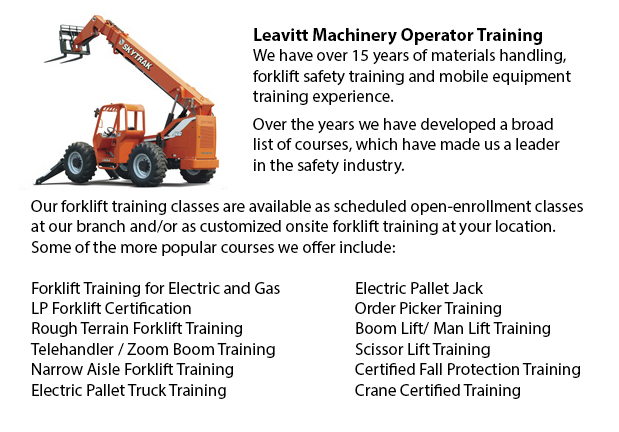
Zoom Boom Training Saskatchewan - Zoom Boom Training is intended to train operators on variable reach forklifts. The objectives of the training are to impart an understanding of the physics of the equipment, and to be able to outline the operator's job. This course follows North American safety standards for lift trucks. Zoom boom training and certification is available at our site or at the company's location, provided there are a minimum number of trainees. Certification given upon successfully finishing it is good for three years.
The telehandler or also known as a telescopic handler is similar in various ways to a common forklift or a crane. This useful equipment is made together with a telescopic boom that can extend forward and lift upwards. A variety of attachments could be fitted on the end of the boom, like for example pallet forks, bucket, lift table or muck grab. It is popular in industry and agriculture settings.
The telehandler is a common utilized along with fork attachments in order to enable the transporting of loads. Telehandlers have the advantage of being able to reach those inaccessible places which can't be reached by a standard forklift. Telehandlers are capable of removing palletized loads from within a trailer and putting them on places which are high such as rooftops. For certain applications, they could be more efficient and practical as opposed to a crane.
The disadvantage of the telehandler is its unsteadiness when lifting heavier loads. As the boom extends with a load, the unit becomes ever more unstable. Counterweights located at the back help, but don't solve the problem. When the working radius increases, the lifting capacity quickly decreases. Various equipment come with front outriggers that extend the lifting capacity while the machinery is stationary.
In order to know whether a load is too heavy, the operator can check with the load chart. The factors covered in the calculation consists of load weight, boom angle and height are calculated. Several telehandlers have sensors that cut off further control or provide a warning if the unit is in danger of destabilizing.
-
Forklift Ticket Saskatchewan
Forklift Ticket Saskatchewan - Pallet jacks and forklifts are both meant for basically the same purpose; to move supplies from one location of your warehouse to another. This is pretty much where the comparison stops however. With the pallet jack, th... More -
Loader Ticket Saskatchewan
Loader Ticket Saskatchewan - Gehl articulated loaders have been made to suit practically any condition. They provide great traction and optimal maneuverability due to a heavy-duty oscillating joint that offers forty five degree rotating angles left a... More -
Forklift Training Programs Saskatchewan
Forklift Training Programs Saskatchewan - Are you searching for work as a forklift driver? Our regulatory-compliant mobile equipment operator training provides instruction in kinds of forklifts, pre-shift check, fuel kinds and handling of fuels, and... More -
Heavy Equipment Operator Classes Saskatchewan
Heavy Equipment Operator Classes Saskatchewan - A heavy equipment operator is an individual who has received the right training in order to operate a particular kind or piece of machinery. There are lots of ways for the operator to undergo training a... More -
Telehandler Training in Saskatchewan
Telescopic handlers usually known as telehandlers for short, are an extremely popular piece of heavy construction equipment. They are usually utilized in the construction and agricultural trades. These equipments have farthest reaching capacity and a... More -
Narrow Aisle Forklift / Order Picker Training / Electric Pallet Jack / Electric Pallet Truck Training in Saskatchewan
A pallet lift is a piece of equipment dedicated in the transporting of pallets of various dimensions and weights. They can be utilized as an attachment for forklifts, cranes and other types of heavy machinery or be applied on their own. Pallet lifts... More -
Operator Safety Training, Re-Qualification Training, In-House Instructor Training in Saskatchewan
Used in just about all industrial construction sites, warehouse operations or boat yards, the lift truck is a very important component so as to help pick up and transfer supplies. The reach feature of a forklift can help improve the applications whic... More -
Aerial Lift Ticket Saskatchewan
Aerial Lift Ticket Saskatchewan - Boom vehicle are often used by phone, cable and utilities firms as they have extended folded arms which are generally folded over the roofs of business vehicles. On the end of the extension of extendable arms usually... More

Forklift Training Saskatchewan
TOLL FREE: 1-888-254-6157
Saskatoon, Saskatchewan
forklifttrainingsaskatchewan.com
Email Us
About Us



